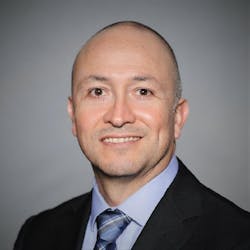In a recent survey designed to gauge the process industry’s progress on its digital transformation (DX) journey, the vast majority of respondents indicated that such initiatives would have a high (60%) or moderate (36%) impact on their organizations’ operations in the next two or three years. Also, with a new urgency instilled by the COVID-19 pandemic, more than half of respondents (51%) had already begun scaling DX across multiple facilities and business functions. (For more details on the study, download your copy of “Taking Control of Digital Transformation.” )
To better understand the effects that such rising tides in user sentiment —and technological capabilities—portend for the distributed control systems (DCSs) at the heart of most process manufacturer’s operations, Control caught up with Michael Martinez, global distributed control systems leader for Schneider Electric's Process Automation business.
Q: What dynamics underly users’ changing expectations of their DCSs?
Q: Over the past several years, we’ve seen the user community become more vocal about the need for greater system openness, flexibility and the ability to accommodate new digital ecosystem solutions such as those epitomized by the Industrial IoT. The NAMUR Open Architecture vision and the work of the Open Process Automation Forum also come to mind. How do you expect that these movements will be reflected in next-generation automation systems?
A: When we at Schneider Electric talk about the future of automation, we see it characterized by three key attributes: it’s open, it’s democratized, and it’s empowering. These three words set the framework for what we see as the future.
Open means different things to different people and organizations, but for us its core meaning is an open automation platform that is entirely independent of the hardware on which it runs. It’s more than just a decoupling of hardware and software, it also means software applications from multiple suppliers can communicate and work together on hardware from an entirely different set of technology suppliers. It’s a level of independence that’s more far-reaching than many of our competitors are thinking about.
In the marketplace, we see suppliers acting on three different visions of open, the first of which has to do primarily with data and communications: we all speak OPC UA, for example, so we can all communicate and share data, we can all manipulate that data and act upon it. The second vision more closely resembles the Apple ecosystem, in that all my stuff seamlessly works with all my other stuff, as long as they’re all Apple stuff.
We subscribe more closely to what I would call the Android version of open, in that there’s a commonly defined operating kernel, or runtime execution engine, that can run on computing hardware in a range of form factors from a variety of suppliers. This runtime, in turn, enables software from a variety of suppliers—the apps that run on your Android phone, to extend the metaphor—to run together on that hardware, sharing data and interoperating with one another. One tangible example of this third sort of openness is UniversalAutomation.org, which provides just that sort of runtime for real-time automation systems and can enable the sort of reference architecture described in the Open Process Automation Forum’s vision. More than 35 organizations already have joined UniversalAutomation.org, and we believe their model will shape the future of process automation systems. This model is also democratized in that technology providers compete on an equal footing, and users can mix and match best-in-breed applications for different functions.
Q: That explains open and democratized, but what about that third characteristic “empowering”? Something tells me you mean more than just more powerful systems than we had in the past.
A: Yes, when we say empowering, it’s much more about the people and organizations who are charged with the configuration and maintenance of these systems. If we go back to those first two visions of “open” that I described, with a universal communications language among systems or a closed ecosystem of components from one supplier that plug and play together, each system still has its own configuration tools and nuances that you have to understand and master. Even more confounding, the constant reconfigurations of organizations often find them stuck with a heterogeneous mix of systems from different suppliers, each with its own unique tools and methodologies. That’s a current skills-management nightmare that only promises to get worse as experienced personnel retire and companies struggle to replace them.
But with the UniversalAutomation.org vision, the runtime is consistent from one supplier to the next, and only the hardware itself varies. On the one hand, this allows you far greater flexibility from a supply-chain perspective to source hardware components from a broader ranger of sources, increasing the likelihood of both availability and proximity, compared with a single-supplier approach. And if a new instrument or new networking technology is developed, every system supplier doesn’t need to take a year-and-a-half to embed it in their systems. Rather, it’s a relatively simple test that this universal automation runtime will run on that hardware, and users can add that new technology to their systems almost immediately.
Q: How has the user community responded to this future vision thus far?
A: When we sit down to talk with our customers about digital transformation, about what the future holds and what success would look like, at the end of the day it all comes down to the fact they’ve only got so many people to do so much.
They’ve made investments in technologies like advanced process control (APC) and other types of high-level analytics, even machine learning and artificial intelligence in some instances, but they can't leverage it because they're spending in some instances up to 80% of their time managing the technology, managing its lifecycle. Operator consoles, for example, are often based on commercial off the shelf (COTS) workstation and server technologies and they only get five to seven years of use out of them. It’s not something we did wrong, but it’s the technology that was available and we’ve chosen as an industry. And even if the plant only gets a planned shutdown once every five years; all their time is spent planning for that next turnaround. They’re spending all their time supporting the technology, not figuring out how to get the most out of their APC application.
This brings us back around to responsible profitability, in that in order to accomplish those higher-level objectives, to drive sustainability and real-time energy management, you have to have the mental space and the human bandwidth to focus on them. Right now, the more things we add to the equation, the more we make it more complex, the greater burden we're putting on the process engineer. In many cases they’re only able to maintain the status quo.
We as an industry are responsible for binding these things together, and now that we can unbundle them, now that we can start to take full advantage of the automated tools and methodologies developed by our counterparts in the IT world, we can finally let our people do what they’re good at and what we, as a society need for them to do.


